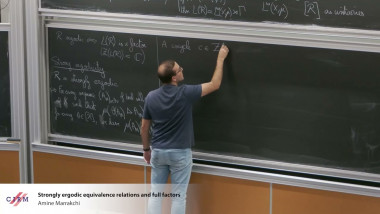
Strongly ergodic equivalence relations and full factors
By Amine Marrakchi
Appears in collections : Combinatorics, automata and number theory / Combinatoire, automates et théorie des nombres, Ecoles de recherche
Subshifts of finite type are of high interest from a computational point of view, since they can be described by a finite amount of information - a set of forbidden patterns that defines the subshift - and thus decidability and algorithmic questions can be addressed. Given an SFT $X$, the simplest question one can formulate is the following: does $X$ contain a configuration? This is the so-called domino problem, or emptiness problem: for a given finitely presented group $0$, is there an algorithm that determines if the group $G$ is tilable with a finite set of tiles? In this lecture I will start with a presentation of two different proofs of the undecidability of the domino problem on $Z^2$. Then we will discuss the case of finitely generated groups. Finally, the emptiness problem for general subshifts will be tackled.
